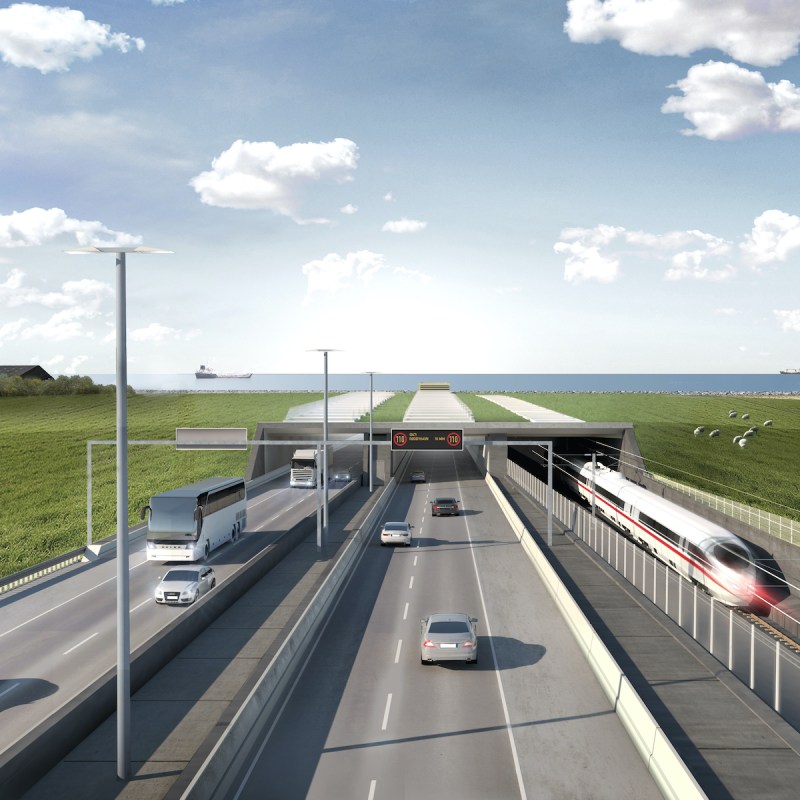
(Photo Credit: Femern A/S)
When it’s finished, the Fehmarnbelt tunnel, which will link Denmark and Germany, will be the world’s longest immersed tunnel. In an important milestone, dredging the trench for the 18-kilometer, or 11.1-mile, tunnel is now half finished.
Videos by TravelAwaits
“We are, of course, delighted that the work is progressing on schedule,” said Henrik Vincentsen, CEO of Femern A/S, the Danish developer managing the project, according to Ground Engineering.
“Our focus is now on the project’s next goal. For us, it is important that the construction of the Fehmarnbelt tunnel is built as sustainably as possible,” Vincentsen explained. “Wherever possible, we and our contractors try to identify opportunities to optimize the project for environmental reasons and to contribute our know-how for future infrastructure projects.”
The Fehmarnbelt tunnel will connect Rødbyhavn on the island of Lolland in Denmark and Puttgarden in northern Germany. The tunnel, which is expected to open in 2029, will feature a four-lane highway as well as two railway tracks.
Dredging operations began in July 2021 and are expected to be completed in 2024. Ultimately, up to 19 million cubic meters of soil will be dredged and then used to build new nature and recreational areas, Femern A/S explains.
The Tunnel’s Benefits
The idea to connect Denmark and Germany by either a bridge or tunnel had been considered for years. Finally, construction on the Fehmarnbelt tunnel began after 10 years of planning.
When it’s completed, the tunnel will make commuting easier. Indeed, the trip between Rødbyhavn and Puttgarden will take 7 minutes by train and 10 minutes by car. Consequently, those travelers will save approximately 1 hour by not having to take a ferry for the crossing, according to Femern A/S.
More significantly, the Fehmarnbelt tunnel will play an important role in the “green transition” of the European transportation network. That’s because enabling traffic to use the shortest and fastest route will reduce CO2 emissions while also freeing capacity on roads and railways.
What’s more, Denmark is also building rail connections to and from the tunnel for electric trains capable of running at speeds of up to 200 kilometers, or about 124 miles, per hour. Using these trains will, of course, shorten travel times, but they will also enable reducing CO2 emissions because travelers won’t need to rely on buses.
A Unique Approach
For comparison, the 50-kilometer (31-mile) Channel Tunnel linking England and France, was built using a boring machine, rather than through immersing pre-built tunnel sections.
Here’s how the Fehmarnbelt tunnel will be built. First, a tunnel portal is being built in both Denmark near Rødbyhavn and in Germany near Puttgarden. These portals connect the tunnel’s railway and highway with each country’s roads and railways.
After that, 79 standard and 10 special elements — or sections — will be built. Each standard element is 217 meters long (almost 712 feet) and weighs over 81,000 tons.
Each element will then be fitted with waterproof bulkheads and then towed into place before being lowered into the seabed by cranes. Once in position, they will be fitted together.
Once all of the elements are connected, the next phase of construction is to begin what Femern A/S calls “technical and mechanical installations.” This work includes everything from laying railway tracks and highway lanes to installing ventilation, cameras, and communication systems.
The entire project is expected to be completed in time for the tunnel to open in mid-2029.
For more about fascinating bridges you can drive across, be sure to read:
